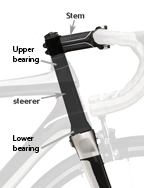
Figure 1:
Direct-connect (threadless) headset
The headset (Figure 1) is the bearing system that allows rotation of the fork, stem, and handlebar so you can steer the bicycle. These instructions explain inspection, lubrication, and adjustment of the headset.
Read the Warning About Mechanical Work before performing any service work on your bicycle.
Warning—An improperly adjusted headset can cause you to lose control and fall. Make sure the headset is properly adjusted before riding the bicycle.
|
|
Figure 1: Direct-connect (threadless) headset |
Once a month inspect the headset of your bicycle to see that it is not loose, nor too tight. If your headset bearings are loose or too tight, do not ride the bicycle; take your bicycle to your Trek dealer for service.
1. Stand over the top tube of your bicycle with both feet on the ground.
2. Apply the front brake firmly while you rock the bicycle forward and backward.
3. Look, listen, and feel for looseness of the headset bearings.
With your fingers, try to spin the spacer(s) under the stem. They should not move.
1. With the front wheel off the ground, slowly rotate the fork and handlebars to the right and left.
2. Look, listen, and feel for any grinding noises, sticking, or binding at any point in the rotation; the bearings may be too tight.
Headset bearing adjustment requires special tools and training, and should only be performed by your Trek dealer.
If your fork uses the threadless, or direct-connect, headset and stem system, make sure your bike has the minimum required spacers as explained in the requirements for stem and spacers in the Fork section.
Once a year re-grease the headset. This requires special tools and training, and should only be performed by your Trek dealer.